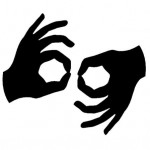
American Sign Language has its own set of cultural norms and its own community. The people that bridge the gap between the deaf community and hearing people are ASL interpreters. These people are highly skilled and trained specifically for this purpose.
One of the most beautiful, smooth, and expressionistic languages in the world completely disregards sounds coming out of your mouth; rather, it features the use of your hands, eyes, mouth shapes, and facial expressions.
What language is this? Sign Language of course! Or more specifically, American Sign Language, commonly referred to as ASL. To give you a little background on ASL, here are some stats:
Here in the United States there are approximately 600,000 deaf individuals, not counting people that classify themselves as hard of hearing. Of the 600,000, many of these people would identify themselves as part of the deaf community which has its own set of cultural norms and practices. Unfortunately, this whole culture and language is ill-known to most hearing people unless they have deaf relatives, friends, or have taken ASL classes during their schooling. This often leads to misunderstandings, false assumptions, and information being lost in translation.
As with all languages, interpretation is necessary when it comes to bridging the gap between hearing people and deaf people. However, being an ASL interpreter takes a lot more than just being bilingual. This means that just because someone can speak English and also fluently sign does not mean they are fit to be an interpreter, in fact, they have a long way to go.
So what’s it take to be an interpreter for ASL? Well, in the near future you will have to at least have a bachelor’s degree. This is because you need a wide variety of vocabulary and general knowledge in order to mix and match the sometimes rough translations from word to sign. After you have prepared yourself with education and experience, you can then take the NIC, or National Interpreter Certification. The NIC has three levels: the normal certification, the advanced certification, and the master certification.
Learning ASL in itself is a commendable and rewarding experience, but taking the extra step to becoming a certified interpreter literally pays off. These jobs range from part time to full time and offer a substantial amount of cash!
Picture taken from: http://www.ods.ohio-state.edu/services/a-s-l-interpreting-services-for-campus-events/
Stats: http://research.gallaudet.edu/Demographics/deaf-US.php




Leave Your Comments Below